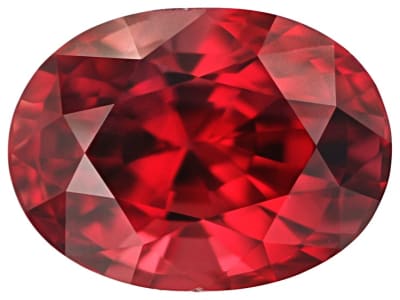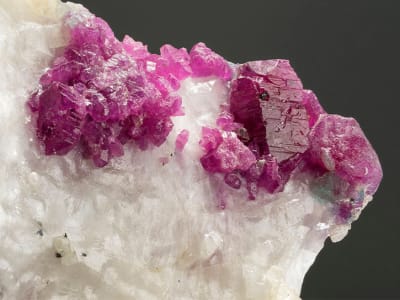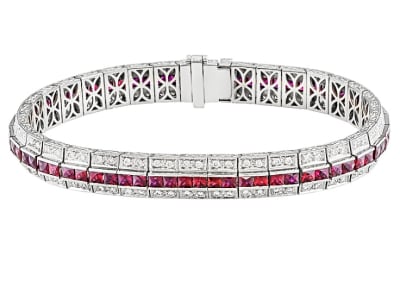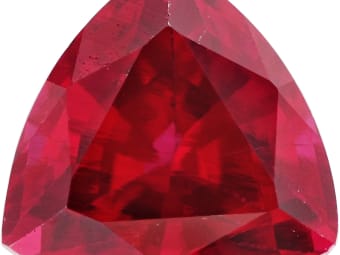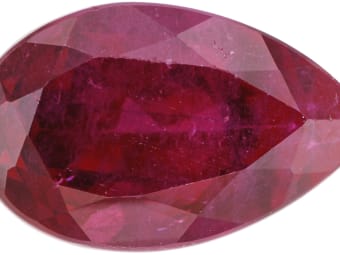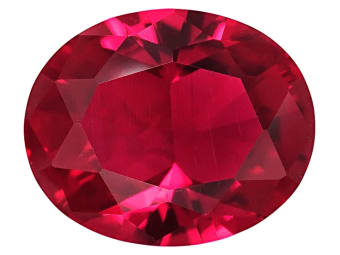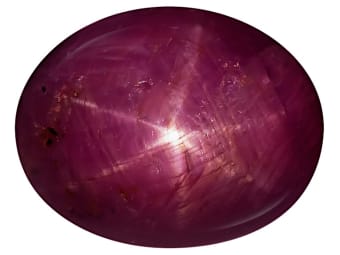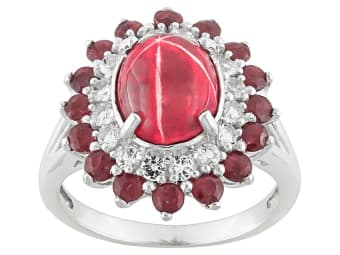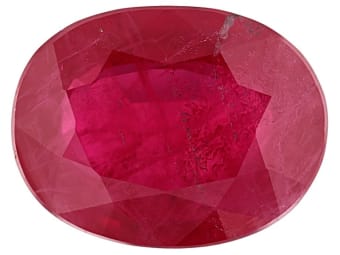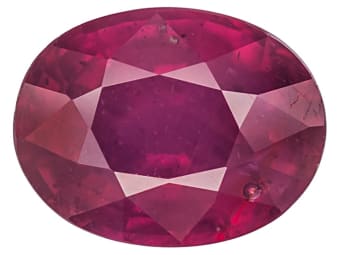Ruby is the red variety of corundum. It is one of the most highly prized gemstones and the finest stones command the highest prices per carat at auction. The name is derived from the Latin word ruber (red). It was called ratnaraj, meaning the "King of Gems" by ancient Hindus. The line between ruby and pink sapphire is not clearly defined and can be quite subjective. It is the birthstone for July. Around 1910 the first synthetic ruby was available in the marketplace. Flame-fusion lab created ruby may be cut from boules weighing in excess of 400 carats.
General Information
Tolerance:(+0.009/-0.005)
LWUV: Weak to moderate red
Ruby Colors
-
 Red
Red -
 Red
Red -
 Red
Red
Ruby Spectra
We acknowledge the significant scientific contributions of John S Harris, FGA to the study of gemstone spectra and with deep appreciation to him, acknowledges the use of his images and related notes about gemstones and their spectra in the educational materials on this website.
Alternate Names
Mahaleo Ruby
Countries of Origin
Tanzania, United Republic Of; Myanmar; Afghanistan; Russian Federation; Viet Nam; Czechia; Guinea; United States of America; Madagascar; Thailand; Sweden; Mozambique; Pakistan; Morocco; Unknown; China; Brazil; Nigeria; Argentina; Sri Lanka; Zambia; Kenya; Switzerland; India; Norway; Namibia; South Africa; Ethiopia; Greenland; Tajikistan; Indonesia
History
Rubies. We desire them. Their rich reds are powerful, seductive, and inflaming. Ruby has been a treasure for centuries - the ancient Hindus named it the King of Gems. In fact, the Sanskrit word for ruby is ratnaraj, which means, "the King of Gems." Ruby is considered the gemstone of passion and of lovers; it's the quintessential symbol for red. Fine rubies are among the most costly and valuable gems of the corundum family, which includes sapphires in all colors (except red). Ruby is a 9 on the scale of hardness, so it's a fabulous choice for a wear-every-day, signature gemstone. It's red color works with white, rose, or yellow metals, which means you have plenty of options in jewelry. July babies, this is your birthstone. But move over - there are plenty of us who wear rubies for the sheer beauty of them!
Care
Untreated and heated rubies just need normal care. Avoid recutting or chipping coated or surface diffused stones. Avoid common household chemicals, steam cleaners, ultrasonic cleaners and a jeweler’s torch with lead glass filled, dyed or oiled/resin filled stones.
More About Ruby
Rubies rank among the four gemstones once called precious: diamond, emerald, ruby and sapphire. Their red color has put them in the forefront of folklore for centuries. The early Burmese thought ruby would impart invulnerability to the wearer, which made it a must in battle. In the middle ages, it was believed that ruby had an inner fire that could not be extinguished. And in the 16th century it was written that ruby had magical powers and could, "preserve health, remove evil thoughts, reconcile disputes and control amorous desires"... among other things. Choose your ruby, get it home, wear it and enjoy it. You'll see why we at JTV® revere it.
Creation Method
Lab Created Czochralski
Synthetic ruby can be created in many ways, one of which is called the Czochralski method. During this process, the various elements that make up ruby are melted in a platinum crucible. A small gem crystal (called a seed) attached to a rod is then dipped into the melt and slowly pulled away as the crystal grows around the seed. For this reason, the Czochralski method is also known as crystal pulling. Synthetic gems have the same chemical, optical, and physical properties of their natural counterparts, but are a more cost-effective alternative to a natural gem.
Lab Created Hydrothermal
Hydrothermally grown synthetic rubies crystallize slowly out of a solution (a mix of water and dissolved elements) that has been exposed to heat and pressure similar to the conditions on Earth under which the natural gem mineral grows. Synthetic gems have the same chemical, optical, and physical properties of their natural counterparts, but are a more cost-effective alternative to a natural gem.
Lab Created Flux
One method of creating synthetic ruby is called flux growth. During the flux growth process, flux, a substance that reduces the melting point of surrounding material, is combined, in a metal-lined crucible, with the elements that make up a specific gem mineral. The crucible is heated until its contents are liquid and then it is allowed to cool very slowly. As cooling continues, the gem mineral crystallizes from the solution. Flux grown synthetic gems can take up to a year to grow to a facetable size, but the exceptional clarity of these gems is well worth the wait! Synthetic gems have the same chemical, optical, and physical properties of their natural counterparts, but are a more cost-effective alternative to a natural gem.
Lab Created Flame Fusion
The flame fusion process for creating gems, also called the Verneuil process, is the most affordable and common synthesis method for producing corundum (ruby and sapphire) and spinel. Powdered chemicals (the building blocks of the gem) are dropped through a high-temperature flame. The molten powder repeatedly falls from the flame onto a rotating pedestal, creating a synthetic crystal, called a boule, which can later be faceted into a gemstone. Synthetic gems have the same chemical, optical, and physical properties of their natural counterparts, but are a more cost-effective alternative to a natural gem.
Lab Created Floating Zone
One method of creating synthetic ruby is called floating zone. In this method of gem synthesis, originally developed by engineers to create super pure silicon, a sintered rod of powdered material, comprised of elements necessary for the gem to grow, is heated with infrared radiation in a vacuum while the ends of the rod are rotated in opposite directions. Since all impurities including air are removed during crystallization, very clean crystals can form.
Optical Phenomena
Star
Star rubies will have silk or sets of parallel rutile needles that produce a 6-ray star, hexagonal growth lines, color zoning and mineral inclusions. Weak and less well-formed stars along with weaker body color is typical of natural stones. In natural stones at least one ray of the start will be perpendicular to the hexagonal growth zones.
Cat's Eye
The term cat's eye, or chatoyancy, is used to describe a phenomenal optical property in gemstones, in this case ruby. The effect, when present, appears as a bright, narrow slit similar to the pupils in the eyes of your favorite feline. This phenomenon is caused by parallel fibrous or needle-like inclusions that interfere with the passage of light through the crystal, scattering and reflecting light back to the viewer as a thin line.
Lab Created Flame Fusion Star
Synthetic star ruby exhibits the optical phenomenon called asterism, a star-like pattern created on the surface of a gemstone when light encounters parallel fibrous, or needle-like, inclusions within its crystal structure. Light that strikes the inclusions within the gem reflects off of the inclusions, creating a narrow band of light. When two or more intersecting bands appear, a star pattern is formed. The flame fusion process for creating gems, also called the Verneuil process, is the most affordable and common synthesis method for producing corundum (ruby and sapphire) and spinel. Powdered chemicals (the building blocks of the gem) are dropped through a high-temperature flame. The molten powder repeatedly falls from the flame onto a rotating pedestal, creating a synthetic crystal, called a boule, which can later be faceted into a gemstone. Synthetic gems have the same chemical, optical, and physical properties of their natural counterparts, but are a more cost-effective alternative to a natural gem.
Lab Created Czochralski Star
Synthetic star ruby exhibits the optical phenomenon called asterism, a star-like pattern created on the surface of a gemstone when light encounters parallel fibrous, or needle-like, inclusions within its crystal structure. Light that strikes the inclusions within the gem reflects off of the inclusions, creating a narrow band of light. When two or more intersecting bands appear, a star pattern is formed. The Czochralski process of gem synthesis involves the melting of various elements in a platinum crucible. A small gem crystal (called a seed) attached to a rod is then dipped into the melt and slowly pulled away as the crystal grows around the seed. For this reason, the Czochralski method is also known as crystal pulling. Synthetic gems have the same chemical, optical, and physical properties of their natural counterparts, but are a more cost-effective alternative to a natural gem.
Material Combination
Lab Created Ruby Overgrowth on Natural Corundum Seed
Synthetic ruby overgrowth corundum has a layer of lab created ruby grown on a colorless corundum.
Enhancement
Flux Healed
Flux healed rubies have been heated in the presence of a flux material like borax. The flux will penetrate fissures in the stone and will act like a catalyst to heal the fracture in the stone. The flux will help melt the surrounding ruby to fill in the fissure and improve the clarity in the stone.
Lead Glass Filled
Lead glass filled rubies have been filled through a process similar to "infilling" using lead glass. Performed at lower temperatures, this is a less durable treatment and should be treated gently, avoiding household and professional chemicals. This treatment improves clarity, color, durability, and may add weight through the filling of voids and fissures.
